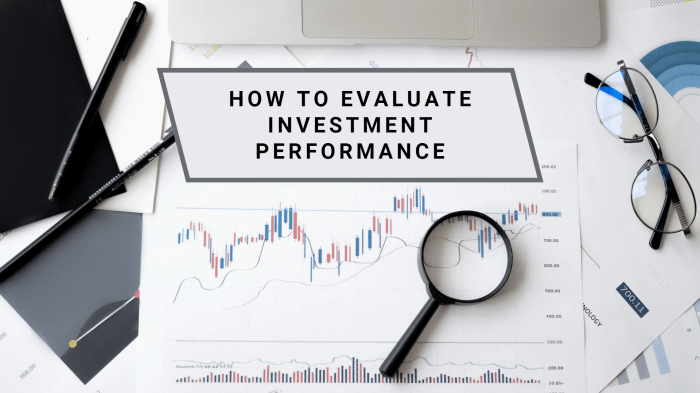When it comes to navigating the world of investments, understanding how to evaluate investment performance can make or break your financial success. From analyzing key metrics to mastering benchmarking, this guide will take you on a journey to demystify the art of investment performance evaluation.
Get ready to dive deep into the realm of investment performance and discover the tools you need to make informed decisions about your financial future.
Introduction to Investment Performance Evaluation
Investing your hard-earned cash is no joke, so you gotta make sure your money is working as hard as you are. That’s where evaluating investment performance comes in handy.
Investment performance evaluation is like a report card for your investments. It helps you see how well your money is doing in the financial jungle out there.
Why Evaluating Investment Performance Matters
- Keeps you in the know: By evaluating performance, you stay updated on how your investments are performing. Knowledge is power, baby!
- Helps you make informed decisions: When you know how your investments are doing, you can make smarter choices about where to allocate your funds.
- Spot trends and patterns: Evaluating performance can help you identify trends and patterns that can guide your future investment strategies.
Key Metrics for Evaluating Investment Performance
Investors use various metrics to evaluate the performance of their investments. These metrics provide valuable insights into how well an investment is performing and help investors make informed decisions.
Return on Investment (ROI)
Return on Investment (ROI) is a fundamental metric used to evaluate the profitability of an investment. It is calculated by dividing the net profit of an investment by the initial cost of the investment and expressing it as a percentage. A higher ROI indicates a more successful investment, while a lower ROI suggests lower profitability.
Sharpe Ratio
The Sharpe Ratio measures the risk-adjusted return of an investment compared to a risk-free asset. It takes into account both the return of the investment and the level of risk taken to achieve that return. A higher Sharpe Ratio indicates better risk-adjusted performance, making it a valuable metric for assessing investment success.
Alpha
Alpha measures the excess return of an investment compared to its benchmark index. A positive alpha suggests that the investment has outperformed the market, while a negative alpha indicates underperformance. Alpha helps investors understand the value added by an investment manager beyond the market return.
Standard Deviation
Standard Deviation is a measure of the volatility or risk associated with an investment. It shows how much the returns of an investment deviate from its average return. A higher standard deviation indicates higher volatility and risk, while a lower standard deviation suggests more stable returns.
Tracking Error
Tracking Error measures the divergence of an investment’s performance from its benchmark index. It helps investors evaluate how actively managed a fund is compared to its passive counterpart. A lower tracking error indicates that the fund closely follows its benchmark, while a higher tracking error suggests more significant deviations.
Comparative Analysis
When comparing these metrics, investors need to consider the specific goals and risk tolerance of their investment strategy. ROI, Sharpe Ratio, Alpha, Standard Deviation, and Tracking Error each provide unique insights into different aspects of investment performance. By analyzing these metrics collectively, investors can gain a comprehensive understanding of the success of their investments and make informed decisions to optimize their portfolios.
Benchmarking in Investment Performance Evaluation

Benchmarking in the context of evaluating investment performance involves comparing the returns of a particular investment against a standard or benchmark. This benchmark could be a market index, a specific fund, or any other relevant measure that represents the expected performance of a similar investment.
Selecting appropriate benchmarks is crucial in evaluating investment performance because it provides a point of reference for assessing how well an investment has performed relative to its peers or the market as a whole. Using an inappropriate benchmark can lead to misleading conclusions about the success or failure of an investment strategy.
Examples of how benchmarking helps in evaluating investment performance effectively include:
Comparing Equity Mutual Fund Performance
- Investors can compare the returns of an equity mutual fund against a relevant stock market index, such as the S&P 500, to determine if the fund has outperformed or underperformed the market.
- By benchmarking the fund against a suitable index, investors can gain insights into the fund manager’s skill in selecting stocks and managing risk.
Evaluating Bond Portfolio Performance
- For bond portfolios, a common benchmark is the Bloomberg Barclays U.S. Aggregate Bond Index. Investors can assess how well their bond portfolio has performed relative to this benchmark to evaluate the effectiveness of their fixed income investment strategy.
- Benchmarking bond portfolios helps investors understand the impact of interest rate changes, credit quality, and duration on their investment returns.
Risk Assessment in Investment Performance Evaluation
Risk assessment plays a crucial role in evaluating investment performance as it helps investors understand the level of risk associated with their investments. By assessing risks, investors can make informed decisions and manage their portfolios effectively.
Methods for Assessing Risks Associated with Investments
- Standard Deviation: Measures the volatility of an investment’s returns over time. A higher standard deviation indicates higher risk.
- Beta Coefficient: Compares an investment’s volatility to that of the overall market. A beta greater than 1 indicates higher risk than the market.
- Sharpe Ratio: Helps evaluate the risk-adjusted return of an investment, considering the level of risk taken to achieve the return.
- Value at Risk (VaR): Estimates the maximum potential loss of an investment within a specific time frame at a certain confidence level.
Impact of Risk Assessment on Investment Performance Evaluation
Risk assessment plays a significant role in the overall evaluation of investment performance. It allows investors to understand the potential risks involved in their investments and determine if the returns justify the risk taken. Moreover, by considering risk metrics, investors can tailor their investment strategies to align with their risk tolerance and financial goals.
